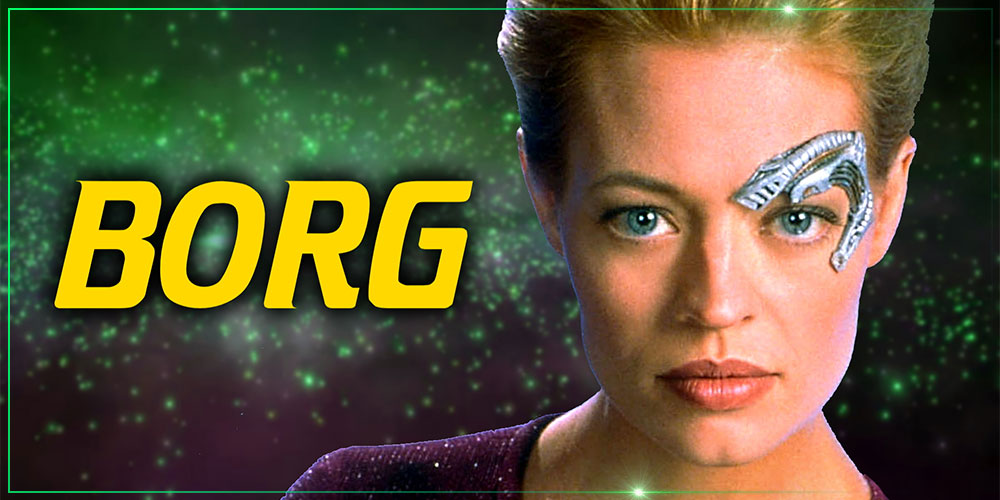The Borg are one of the most recognizable races from Star Trek, both in name and in appearance. The name “Borg” has become synonymous in popular culture with a hivemind society, and this serves well to connote the nature of their Collective. We’re given hints throughout the franchise as to the rough timeframe of their origins, although the true depth of their history, at least in canon, is still a mystery. Today, I’ll examine the various accounts of the Borg’s ancient past and attempt to construct a rough timeline of the Collective and its expansion throughout the Milky Way Galaxy.
For this timeline, I’m actually going to document each theoretical stage of Borg history in reverse chronological order, and then at the end, I’ll recap by going forward in time. And I’m going to be including both canon and non-canon sources so as to not limit our scope, but I’ll be sure to make it clear what I’m referencing.
The most recent “hard date” given in canon for the formation of the Collective is the 15th century AD, specifically the year 1484. According to the Voyager episode “Dragon’s Teeth,” around this time, the Borg controlled only a handful of solar systems in the Delta Quadrant. A species with a connection to every region of the quadrant, the Vaadwaur, considered them a minor nuisance. But as we know, by the 24th century, the Borg have assimilated thousands of systems.
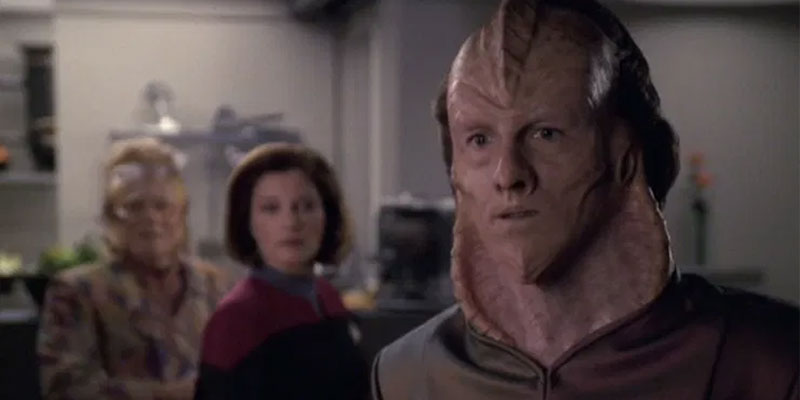
Technically speaking, this 15th-century date is not necessarily the origin of the Borg per se, but the extent of their reach nearly a millennium before Voyager takes place. The Destiny novel series suggests they arose from a colony of the Caeliar species around 4527 B.C. According to this account, the Borg Collective was created by the forcible merging of the Caeliar, former inhabitants of the Azure Nebula, with temporally displaced human Starfleet officers and MACOs from the 22nd century. The Caeliar subsequently assimilated the planet Arehaz, where the merging took place and expanded from there.
But according to Guinan in The Next Generation episode “Q Who,” and expounded upon in Star Trek: First Contact, the Borg have been developing for thousands of centuries—dating back to at least the Pleistocene epoch. Guinan and the Borg Queen indicate that the Borg has evolved into a mixture of organic and artificial life with cybernetic enhancements. During this phase of their existence, according to William Shatner and Judith and Garfield Reeves-Stevens’ 1996 Trek novel “The Return” and Michael Jan Friedman’s 1999 Trek short story “The Hunted,” the Borg assimilated many worlds throughout the Delta Quadrant, including the homeworld of the Hirogen, later the namesake for a massive communications relay network found by Voyager.
“But wait,” I hear you say, eagerly, “didn’t you just get through talking about how the Borg only controlled a handful of systems in the 15th century? Why are you including non-canon sources that contradict the shows and movies?” Well, this gets at the heart of one of the most interesting phenomena I encountered when doing research on the Borg—in fact, you could say it’s one of the things that inspired me to make this episode in the first place. Not many are familiar with this hypothesis, but as various Star Trek fans and novelists have speculated, it’s possible that there were multiple “incarnations” of the Borg, with multiple “waves” of expansion and contraction of their territory defining their true history. This is how the Borg could be described as a small nuisance much more recently and as a major galactic player, thousands of years before that—the Borg that our Starfleet heroes encounter on screen is merely the latest incarnation of the Borg.
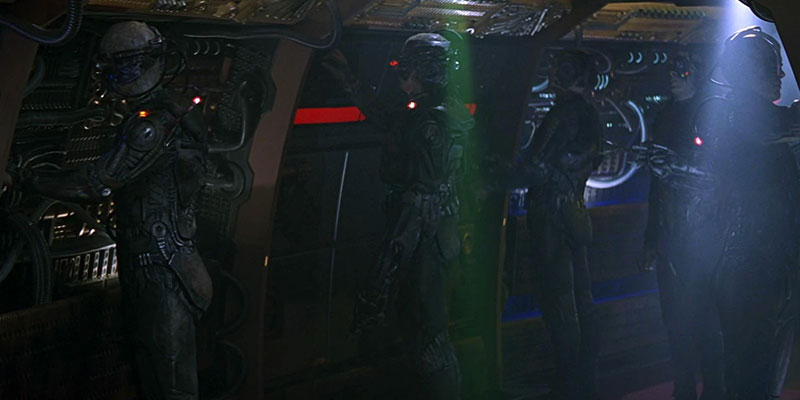
This is a theory that is, admittedly, highly speculative, as it incorporates story elements outside of the canon we’re shown on screen. But for the sake of this timeline, I think it’s interesting to ponder the implications of multiple Borg incarnations. The “incarnations” could be defined either as different tribes with different approaches to managing the Collective or completely separate species entirely, recurring periodically like a universal constant. When examined in this fashion, it becomes clear that the Borg is like a virus—from a singular origin point, they can spread and infect other beings in the galaxy, mostly concentrated in the Delta Quadrant. After their decline due to some hypothetical unforeseen disaster, a “mutation” can resurge and repeat the process all over again.
This contextualizes a lot of other Borg encounters documented in various other novels, short stories, and video games. In Gene DeWeese’s 1992 novel Probe, it’s said that the Borg attempted to assimilate the Cetacean Probe seen in Star Trek IV: The Voyage Home around 307,000 years ago. The assimilation failed, although they did succeed in damaging the probe’s computer core—this is given as an explanation as to why the probe tried to damage Earth’s atmosphere in The Voyage Home. The Borg subsequently attempted to assimilate the homeworld of the probe’s creators, but the creators fought back, eventually escaping from the Borg threat in a manner somewhat similar to the El-Aurian’s—Guinan’s race.
If we keep going back even further, we eventually run into supposed interactions between the Borg and the Preservers billions of years ago. The Preservers are, of course, another ancient race who are responsible for transplanting various endangered cultures from place to place throughout the galaxy. Their canon activities date to just a few thousand years ago according to The Original Series episode “The Paradise Syndrome,” but TNG writer Ronald D. Moore has given credence to the idea that the Preservers are the same species as the ancient humanoids featured in “The Chase.” Despite the age difference, as the ancient humanoids lived 4.5 billion years ago, this connection is confirmed in Star Trek Online and various other non-canon sources.
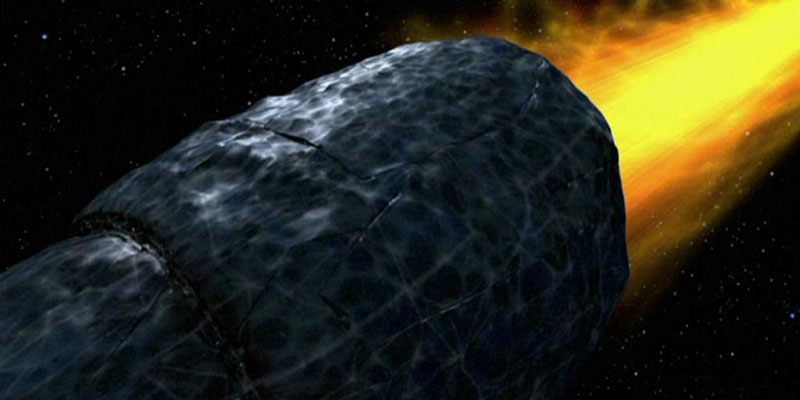
As far as the Preservers’ encounters with the Borg go, Peter David’s 1991 novel Vendetta and the 2001 Voyager comic “Planet Killer” suggest that Borg fleets threatened the Preservers and may have even driven them close to extinction. This could have resulted in a long period of galactic history without the Preservers’ influence before their resurgence far down the line. Furthermore, it’s suggested that the Preservers, in a last-ditch effort, created neutronium-powered Doomsday devices, or “planet killers,” such as the one featured in The Original Series episode “The Doomsday Machine.” Pretty cool. These Doomsday devices would have been created to keep the Borg in check, but none were ever activated, being left to wander the galaxy for eons.
In all of these accounts, though, one thing remains consistent across interpretations—even given a plain, simple reading of the Borg Queen’s dialogue in First Contact, the Borg most likely started out as a normal, regular civilization where it seems that experiments with artificial intelligence and cybernetic enhancement went awry. This may be what has happened multiple times to cause resurgences of the Borg, with a new “species zero” starting off the chain reaction each time. In fact, in three separate Star Trek short stories and comics—2003’s “The Beginning” by Annie Reed, 2004’s “Forgotten Light” by Frederick Kim, and the 2006 TOS manga “Side Effects” by Chris Dows—three distinct, separate species originally from the Delta Quadrant become the Borg as an unintended consequence of medical experimentation with nanotechnology!
The 2006 videogame Legacy even makes a connection between the Borg and V’Ger from The Motion Picture, asserting that the Borg are the inhabitants of the “machine planet” that V’Ger encountered. Before his death, Gene Roddenberry remarked that this could be the case, but it was never explicitly said anywhere else, canon or not—and many dismiss this Borg-V’Ger connection as unnecessary as it makes the universe smaller and creates a narrative simply out of the human desire for structure and order. Another reason this connection is dubious is because V’Ger’s path to the Sol system takes it through Klingon territory, which is in the opposite direction from the core of the Federation than the Delta Quadrant. Even if V’Ger traveled through a black hole to get back home, one could argue the connection is forced—although we can’t know for sure.
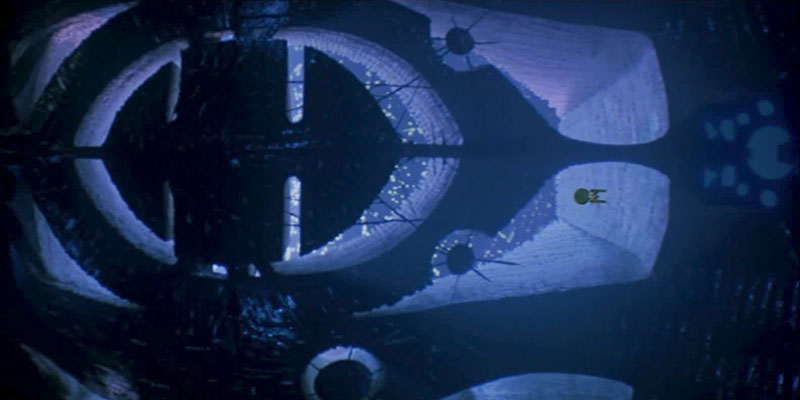
In any case, the fact that all the incarnations, as far as we’re aware, have been in the Delta Quadrant is curious—it is somewhat indicative of the fact that the Borg in canon may have been intended to just be one singularly advancing species, starting in the Pleistocene and culminating in the Borg we’re familiar with on-screen. But even given the lack of canon evidence for some of these earlier incarnations, the truth is that the galaxy is a big place, and there’s a LOT of time one can cover when delving into the depths of galactic history. If season 1 of Star Trek: Picard is any indication, then cyclical waves of artificial intelligence rising and falling throughout the galaxy may be the norm, and the Borg, though distinct from androids due to their more explicit mixing of organic tissue, could simply be a variation on that pattern.
So, let’s recap, because there’s a lot here:
- As far back as billions of years ago, one of the earliest incarnations of the Borg may have arisen, presumably one of the child races of the Progenitors (a.k.a. Preservers). These cybernetic beings fought with their creators, eventually destroying them like the Klingons would slay their gods.
- Hundreds of thousands of years ago, an incarnation of the Borg—having assimilated numerous systems throughout the Delta Quadrant—supposedly had encounters with the creators of the Cetacean Probe, as well as the Hirogen and more.
- Another distinct incarnation of the Borg—one of many, in fact—would arise on a planet in the Delta Quadrant as a technologically advanced, scientifically curious race experiments with nanotechnology and things don’t go as planned.
- Towards the end of the Pleistocene and beginning of the Holocene, yet another distinct incarnation of the Borg would arise and begin to assimilate systems in the Delta Quadrant, according to the Last Unicorn RPG module: All Our Yesterdays – The Time Travel Sourcebook.
- Another origin point for the Borg would arise just 5800 years later on the planet Arehaz when temporally displaced Caeliar and Starfleet officers are assimilated.
- Finally, the current incarnation of the Borg would arise in the Delta Quadrant in the late 15th century, controlling a few systems at first and eventually becoming the dominant power in the quadrant.
So, as I mentioned before, most of this information should be taken with a grain of salt as it comes from non-canon sources, and much of it taken together can frankly come off as contradictory. Honestly, that’s because it is. And as some have pointed out, having an air of mystery surrounding Borg’s true origins is quite enticing. But I think the general idea of a Borg Collective that “comes in waves,” rising and falling over millennia and recurring like a virus, is at least interesting to consider. It would actually tie together the two seemingly disparate pieces of dialogue from both The Next Generation and Voyager regarding the Borg’s distant origins, their evolution, and their territorial expansion.
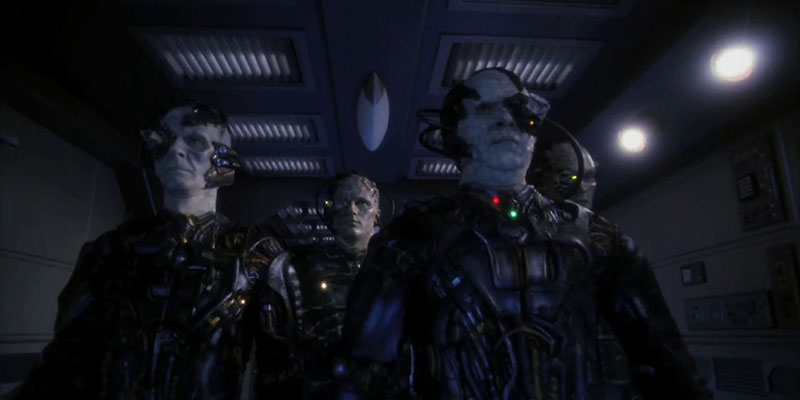
Of course, I would also be remiss if I didn’t mention the very real connection that the Borg share with the Federation and humanity. As we see in Star Trek: First Contact, the Borg’s attempt to disrupt the timeline by preventing Zefram Cochrane’s warp flight in 2063 backfires as the U.S.S. Enterprise-E intervenes, thereby resulting in the restoration of the timeline and creation of a pogo paradox. The consequences of this are further demonstrated in the Enterprise episode “Regeneration,” in which leftover Borg drones frozen in the Arctic are reactivated in 2153 and send a signal with Earth’s coordinates to the Delta Quadrant. This is likely what led the Borg to start making their way towards Federation space by the 24th century, with their first face-to-face encounter facilitated by Q in 2365. See? It’s all connected.
I won’t go in-depth into Borg history as it pertains to what we see in the shows and films, as that is distinctly “current history” as opposed to their ancient origins. Trekspertise has an excellent video where he details Borg history in full, and that video also served as inspiration for my deep dive into the Borg’s origins. I hope that this video has been informative—it certainly was for me.
In the meantime, thanks for watching! I definitely want to hear your thoughts in the comments. If you enjoy content like this, becoming a patron HERE… It is a great way to support me.
Watch The Latest Video By Orange River Media Below
Don’t forget to subscribe, and I’ll see you next time! Live long and prosper.
You can find Orange River Media at the links below
- YouTube: https://www.youtube.com/orangeriver
- Twitter: https://www.twitter.com/orangerivernw
- Instagram: https://www.instagram.com/orangeriver.nw
- Facebook: https://www.facebook.com/orangerivernw
- Patreon: https://www.patreon.com/orangeriver

